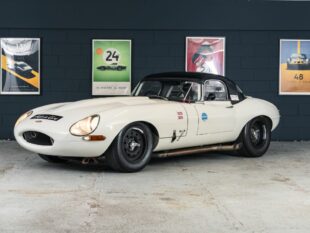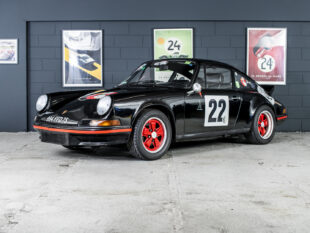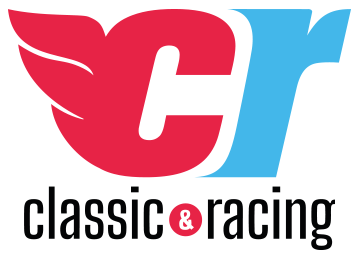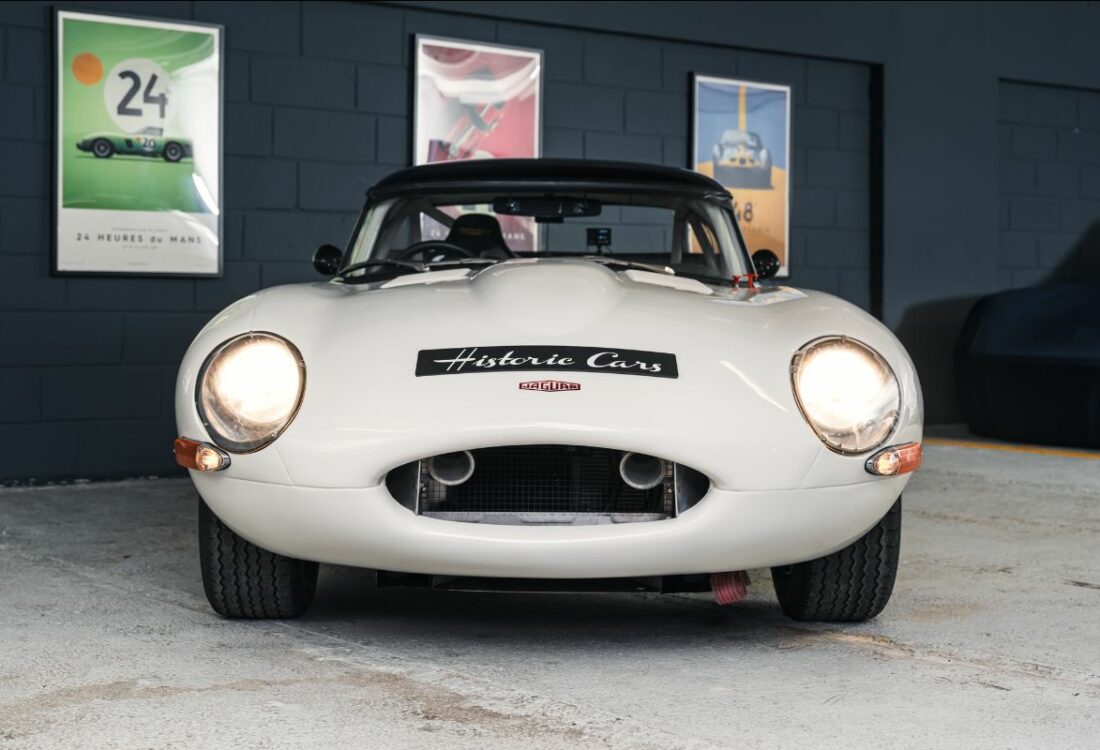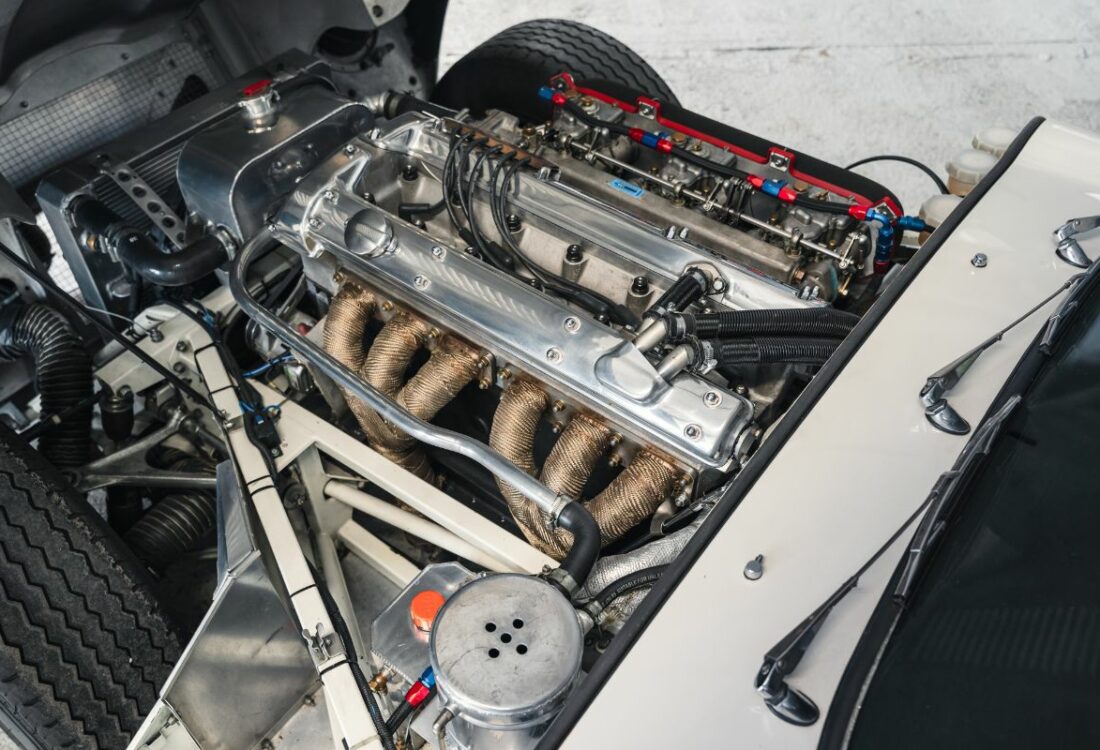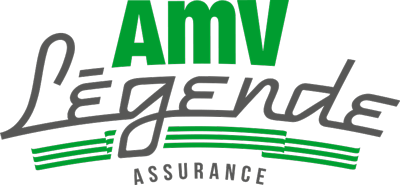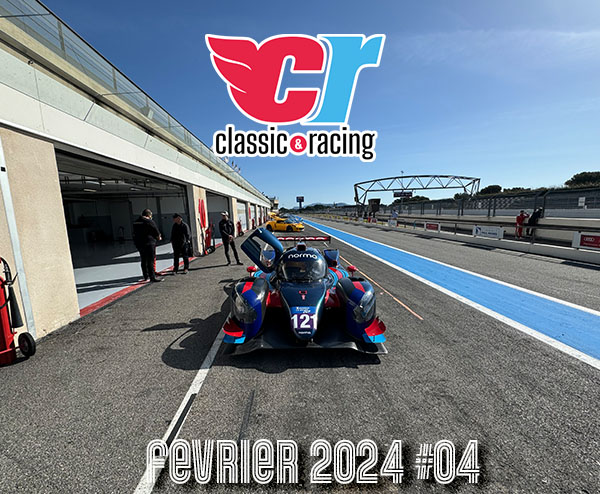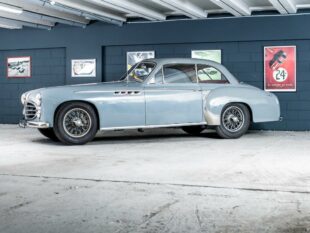
JAGUAR TYPE E
Les services + de Classic Racing
Bientôt disponible

Bientôt disponible
A votre service depuis 1995, Transfret c’est avant tout le respect des collaborateurs et des clients.
Pour transporter de 1 à 6 voitures partout en Europe, contactez nous sur www.groupe-transfret.com
Lorsque Jaguar dévoile sa Type E au salon de Genève en mars 1961, c’est la surprise totale. Surprise, car personne n’avait eu d’informations préalables sur la future Grand Tourisme de la marque de Coventry, et également parce que la ligne de la Type E a totalement subjugué les foules. Une ligne signée William Lyons, un châssis sportif tout en restant confortable et des performances de premier ordre caractérisait alors la nouvelle Jaguar Type E. Sans parler du prix sans concurrence alors, puisque trois fois moins cher qu’une Ferrari et deux fois moins qu’une Maserati…
Depuis la fin de la guerre, Jaguar symbolise à merveille le Grand-Tourisme à l’anglaise. Toute la généalogie des roadsters XK (120 à 150) a largement contribué à construire cette image sportive en complément des nombreuses victoires dans des compétitions majeures. Mais à l’orée des années 60, malgré toutes leurs qualités, les XK ne peuvent masquer leur âge. Alors, en secret, Coventry travaille sur la remplaçante. Les journalistes de l’époque sont alors totalement tenus à l’écart et les quelques dessins de perspective qui sont dévoilés seront loin de la réalité. Le 15 mars au salon de Genève, c’est la cohue de journalistes dans le parc des Eaux-Vives. Tous veulent admirer en avant-première la nouvelle star de Coventry. Puis, c’est le grand bain de foule au salon de Genève. Les commentaires et réactions sont dithyrambiques. A chaque apparition d’une Jaguar Type E, dans la rue, c’est l’attroupement. Nombres de stars et de personnalités se sont empressées de prendre commande de la belle anglaise : Françoise Sagan, Johnny Halliday, Bernard Consten, Charles Trenet, Pierre Bardinon, Robert Hirsch, sans parler des têtes couronnées. Mais non contente de posséder une ligne à couper le souffler, la Jaguar Type E pouvait se targuer de posséder un châssis très en avance pour l’époque…
Pour son châssis, la Jaguar Type E a été l’objet des soins les plus attentifs. En effet, de nombreuses solutions ont été reprises de la compétition. Ainsi, pour la nouvelle GT de Coventry les ingénieurs châssis (Bob Knight et Norman Dewis) ont imaginé un berceau indépendant de la coque. Il reçoit ainsi la suspension arrière, les freins et le différentiel. Il est ensuite rattaché à la coque par des silents-blocs en forme de V. Cela permet ainsi d’isoler l’habitacle de tout parasite provenant des suspensions et/ou des irrégularités de la chaussée. Pour la partie avant, c’est presque un ” copier-coller ” de la structure de la Type D de course. Deux leviers triangulés superposés, dont celui du bas qui accueille l’extrémité antérieure du bras de torsion longitudinal. Pour ralentir son félin aux griffes acérées, Jaguar a repris le principe des freins à disques inauguré avec succès aux 24 Heures du Mans en juin 1953 avec la Jaguar Type C. Les quatre roues en sont équipées et un double circuit de freinage séparé est monté. Avec un poids contenu de 1 220 kg, la Jaguar Type E se targue d’un rapport poids/puissance très flatteur qui lui permet de postuler au statut de véritable sportive. La tenue de route est très moderne et c’est surtout le confort de conduite qui étonne. On comprend mieux pourquoi Jaguar se taillera une réputation à part dans le domaine des châssis.
Notre Jaguar, 3,8L Roadster, a été livrée au distributeur américain à New York le 14 août 1963. Après une vie tranquille aux Etats-Unis, notre voiture est importée en Europe et transformée en 2011 par Martin O’Connell Racing. Il s’agit d’une voiture de course au spécification Semi-Lightweight avec une monocoque en acier, habillée d’un capot, d’un hard top, d’un coffre et de portes en aluminium, également passée chez Pearson Engineering qui en reprendra le set up complet avant que nous ne sourcions la voiture pour un de nos clients en décembre 2019. La boîte de vitesses est une close ratio entièrement synchronisée de chez Denis Welch, la puissance étant transmise par un embrayage de compétition à un différentiel à glissement limité avec refroidisseur d’huile. Étrier avant Jaguar Mk9, jantes Dunlop en alliage de Magnésium, etc… Le moteur « straight port » acier a été reconstruit en 2023 par AS Classic Engineering (Alexandre SURBERE) qui vient d’en faire l’entretien après 10h de roulage. Une récente visite au banc de puissance a permis de constater 320 CV et 417Nm de couple.
Notre type E s’est révélée être une Jaguar très rapide et fiable avec des succès dans le HSCC, les Masters et le E-Type Challenge. Elle a aussi participé à Goodwood à la course dédiée aux Type E, ainsi qu’au Pomeroy Trophy du VSCC en terminant 5ème au classement général ou plus récemment au Mans Classic et au Sixties’ Endurance de Peter Auto.
Accompagnée d’un PTH FIA International valable jusqu’à fin 2030, cette E-Type a toujours été performante et très fiable. Elle est livrée avec un jeu de roues de rechange, une boîte de vitesses de rechange à reconstruire et de très nombreuses pièces de rechange vous permettant de partir l’esprit serein sur n’importe quelle course.
Elle est prête pour la saison 2024 !
![]()
Jaguar Type E 3,8L offered for sale.
When Jaguar unveiled its E-Type at the Geneva Motor Show in March 1961, it was a complete surprise. It was a surprise because no one had received any prior information about the Coventry-based brand’s future Grand Touring, and also because the E-Type’s styling totally captivated the crowds. A line signed by William Lyons, a sporty yet comfortable chassis and first-class performance characterized the new Jaguar E-Type. Not to mention the unrivalled price, which was three times less than a Ferrari and half that of a Maserati…
Since the end of the war, Jaguar has been the perfect symbol of the English Grand Touring. The whole genealogy of XK roadsters (120 to 150) has largely contributed to build this sporty image in addition to the numerous victories in major competitions. But at the dawn of the 1960s, despite all their qualities, the XKs could not hide their age. So, in secret, Coventry worked on a replacement. The journalists of the time were kept completely out of the loop and the few perspective drawings that were revealed were far from reality. On March 15 at the Geneva Motor Show, there was a rush of journalists in the Eaux-Vives park. They all wanted to have a preview of the new star of Coventry. Then, it’s the big crowd at the Geneva show. The comments and reactions are dithyrambic. Each time a Jaguar E-Type appears in the street, there is a crowd. Many stars and personalities were quick to order the beautiful English car: Françoise Sagan, Johnny Halliday, Bernard Consten, Charles Trenet, Pierre Bardinon, Robert Hirsch, not to mention the crowned heads. But not only satisfied with offering a breathtaking line, the Jaguar E-Type could boast of having a chassis very advanced for the time…
For its chassis, the Jaguar E-Type has been the object of the most attentive care. Indeed, many solutions were taken from the competition. For the new Coventry GT, the chassis engineers (Bob Knight and Norman Dewis) designed a cradle that is independent of the body. It receives the rear suspension, the brakes, and the differential. It is then attached to the body by V-shaped silents blocks. This allows to isolate the passenger compartment from any parasite coming from the suspensions and/or from the irregularities of the road. For the front end, it’s almost a “copy and paste” of the D-Type racing structure. Two triangulated levers are superimposed on each other, the lower one hosting the front end of the longitudinal torque arm. To slow down its sharp-clawed feline, Jaguar used the principle of disc brakes, which had been successfully introduced in the 24 Hours of Le Mans in June 1953 with the Jaguar C-Type. All four wheels are equipped with disc brakes and a separate dual braking system is fitted. With a contained weight of 1,220 kg, the Jaguar E-Type boasts a very flattering power-to-weight ratio that allows it to apply for true sports car status. The handling is very modern, and it is especially the driving comfort that amazes. It’s easy to understand why Jaguar has built a reputation for itself in the field of chassis.
Our Jaguar 3.8L Roadster was delivered to the American dealer in New York on August 14th 1963. After a quiet life in the USA, our car was imported to Europe and modified in 2011 by Martin O’Connell Racing. It’s a Semi-Lightweight specification race car with a steel monocoque, dressed up with an aluminum bonnet, hard top, boot and doors. It then passed to Pearson Engineering who will take over the complete set up before we source the car for one of our customers in December 2019. The gearbox is a fully synchronized Denis Welch close-ratio, with power transmitted via a racing clutch to an oil-cooled limited-slip differential. Jaguar Mk9 front calipers, Dunlop magnesium alloy wheels, etc… The cast iron ‘straight port’ engine was rebuilt in 2023 by AS Classic Engineering (Alexandre SURBERE), who has just serviced it after 10 hours on the track. A recent visit to the power bench revealed 320 bhp and 417Nm of torque.
Our E-Type has proved to be a very fast and reliable Jaguar with successes in the HSCC, the Masters and the E-Type Challenge. It has also competed at Goodwood in the dedicated E-Type race, as well as in the VSCC’s Pomeroy Trophy, finishing 5th overall, and more recently in Peter Auto’s Le Mans Classic and Sixties’ Endurance.Accompanied by an FIA International PTH valid until the end of 2030, this E-Type has always performed well and been extremely reliable. It comes with a set of spare wheels, a spare gearbox to rebuild and a host of spare parts to give you peace of mind for any race.
It’s ready for the 2024 season!
Passeports techniques
| Passeport | ASN | Numéro | Extrait |
|---|---|---|---|
| Passeport Technique (3 volets) | |||
| Passeport technique international (PTH) |
Les dernières annonces de Historic Cars
